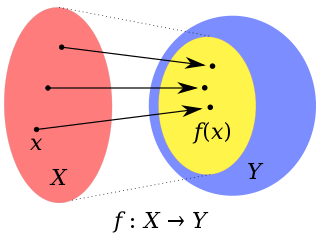
In mathematical analysis, the intermediate value theorem states that if a continuous function, f, with an interval, [a, b], as its domain, takes values f(a) and f(b) at each end of the interval, then it also takes any value between f(a) and f(b) at some point within the interval.
In measure theory, the Lebesgue measure, named after French mathematician Henri Lebesgue, is the standard way of assigning a measure to subsets of n-dimensional Euclidean space. For n = 1, 2, or 3, it coincides with the standard measure of length, area, or volume. In general, it is also called n-dimensional volume, n-volume, or simply volume. It is used throughout real analysis, in particular to define Lebesgue integration. Sets that can be assigned a Lebesgue measure are called Lebesgue-measurable; the measure of the Lebesgue-measurable set A is here denoted by λ(A).
In mathematical analysis, a null set is a set that can be covered by a countable union of intervals of arbitrarily small total length. The notion of null set in set theory anticipates the development of Lebesgue measure since a null set necessarily has measure zero. More generally, on a given measure space a null set is a set such that .

In mathematics, real analysis is the branch of mathematical analysis that studies the behavior of real numbers, sequences and series of real numbers, and real-valued functions. Some particular properties of real-valued sequences and functions that real analysis studies include convergence, limits, continuity, smoothness, differentiability and integrability.
In mathematics, a topological space is called separable if it contains a countable, dense subset; that is, there exists a sequence of elements of the space such that every nonempty open subset of the space contains at least one element of the sequence.
In mathematical analysis and in probability theory, a σ-algebra on a set X is a collection Σ of subsets of X that includes X itself, is closed under complement, and is closed under countable unions (the definition implies that it also includes the empty subset and that it is closed under countable intersections). The pair is called a measurable space or Borel space.
In mathematical analysis, the Haar measure assigns an "invariant volume" to subsets of locally compact topological groups, consequently defining an integral for functions on those groups.
In mathematics, a Borel set is any set in a topological space that can be formed from open sets through the operations of countable union, countable intersection, and relative complement. Borel sets are named after Émile Borel.
In real analysis the Heine–Borel theorem, named after Eduard Heine and Émile Borel, states:
In calculus, absolute continuity is a smoothness property of functions that is stronger than continuity and uniform continuity. The notion of absolute continuity allows one to obtain generalizations of the relationship between the two central operations of calculus—differentiation and integration. This relationship is commonly characterized in the framework of Riemann integration, but with absolute continuity it may be formulated in terms of Lebesgue integration. For real-valued functions on the real line two interrelated notions appear: absolute continuity of functions and absolute continuity of measures. These two notions are generalized in different directions. The usual derivative of a function is related to the Radon–Nikodym derivative, or density, of a measure.
In the mathematical discipline of general topology, a Polish space is a separable completely metrizable topological space; that is, a space homeomorphic to a complete metric space that has a countable dense subset. Polish spaces are so named because they were first extensively studied by Polish topologists and logicians—Sierpiński, Kuratowski, Tarski and others. However, Polish spaces are mostly studied today because they are the primary setting for descriptive set theory, including the study of Borel equivalence relations. Polish spaces are also a convenient setting for more advanced measure theory, in particular in probability theory.
In functional analysis and related branches of mathematics, the Banach–Alaoglu theorem states that the closed unit ball of the dual space of a normed vector space is compact in the weak* topology. A common proof identifies the unit ball with the weak* topology as a closed subset of a product of compact sets with the product topology. As a consequence of Tychonoff's theorem, this product, and hence the unit ball within, is compact.
In set theory, the cardinality of the continuum is the cardinality or "size" of the set of real numbers , sometimes called the continuum. It is an infinite cardinal number and is denoted by or .
In the mathematical field of real analysis, Lusin's theorem states that every measurable function is a continuous function on nearly all its domain. In the informal formulation of J. E. Littlewood, "every measurable function is nearly continuous".
In mathematics, a regular measure on a topological space is a measure for which every measurable set can be approximated from above by open measurable sets and from below by compact measurable sets.
In probability theory, a standard probability space, also called Lebesgue–Rokhlin probability space or just Lebesgue space is a probability space satisfying certain assumptions introduced by Vladimir Rokhlin in 1940. Informally, it is a probability space consisting of an interval and/or a finite or countable number of atoms.

In mathematics, a real-valued function is a function whose values are real numbers. In other words, it is a function that assigns a real number to each member of its domain.




















![Example maps f:(0,1)-[0,1] and g:[0,1]-(0,1). Mutual embedding of open and closed real unit interval svg.svg](http://upload.wikimedia.org/wikipedia/commons/thumb/e/e5/Mutual_embedding_of_open_and_closed_real_unit_interval_svg.svg/250px-Mutual_embedding_of_open_and_closed_real_unit_interval_svg.svg.png)








